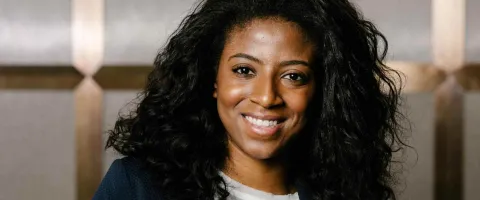Header: Susan Allen © Private
"to belonging" is a long-term project driven by tbd* that aims to change the discourse around diversity and inclusion to one of belonging. Anti-racism, feminism and equity will be the focus of our work and should lead to a radical systemic change in the impact sector, from "power over" and "power for" to "power with". This content series is a part of this project and is made possible by the Open Society Foundations.
The Open Society Foundations are the world’s largest private funder of independent groups working for justice, democratic governance, and human rights. Founded in 1984 by George Soros, the Foundations have grown into a global network working on issues from minority rights to access to health care and women’s rights. Throughout its history, Open Society has responded rapidly with innovative programs to address social, political, and economic change.
Susan Allen is director of Diversity, Equity, and Inclusion (DEI) at the Open Society Foundations. Susan grew up in Massachusetts, USA, and when she was 13 years old, started working at Health Care For All, a health policy non-profit organization. A few years after she finished university in 2008, her mentor at the time encouraged her to apply for a job at the Open Society Foundations. Since joining Open Society in 2010, Susan has had several roles in the Foundations’ New York office, including manager of diversity and inclusion, special assistant to the global director of human resources, program coordinator in the Executive Office, and program associate with the Democracy Fund in Open Society-U.S. In 2016, Susan went to Open Society’s London office to lead the Foundations’ DEI work.
In this interview, Susan gives us an inside view of how Open Society is developing an inclusive culture — from using “listening tours” to creating “inclusion liaison teams” in every office and region. While philanthropic organizations like the Open Society Foundations have more financial resources than most other non-profits, their pluralistic approach to diversity, equity, and inclusion, and Susan’s visionary leadership on these issues, can benefit other organizations seeking a more inclusive and diverse workplace.
Susan, what does diversity, equity, and inclusion, mean to you?
Susan: Put simply, diversity, equity, and inclusion means an organizational culture in which everybody can be comfortable being themselves at work. Team members show empathy and want to learn about others and their perspectives, as well as exhibiting a healthy dose of self-awareness that they don’t know everything. Most importantly, that they don’t even know everything about themselves. Inclusive leaders are those who are willing to adapt and to grow—which is a mindset that really needs to be something that is rewarded across all levels of an organization.
[recommended:14229]
An inclusive workplace is one where nobody is hiding any aspects of themselves. There is a lot of talk about “bringing your whole self to work” these days. It often gets written off as “jargon.” To be frank, it probably does feel like jargon if you are a straight, white man, who doesn’t have to hide or adapt a large part of himself in the work environment. Because that work environment was created for him. If you are gay though, for instance, and you don’t feel like you can bring your partner into conversations, then this is a huge issue. Even company policies, such as parental leave, tend to be centered around heterosexual relationships. It is not about individual assimilation, it is about organizational adaptation. Clearly, you have to have a code of conduct. There are ethical boundaries to what is appropriate behavior at work—but nobody should be hiding parts of their identity.
Have the Open Society Foundations always had this kind of inclusive environment? Or have you had to work for it?
Susan: No, we have had to be very intentional about this, just like any organization. In terms of our external work, we have supported issues like progressive drug policy, criminal justice reform, and legalizing sex work, which disproportionately impact communities that have been marginalized by various forms of oppression. We’ve been working on these issues for longer than many other philanthropic and social justice organizations.
In terms of our internal work, we have been making an intentional effort to center diversity, equity, and inclusion in our culture and strategy. This requires thoughtful leadership and action from both executive management and our staff. We now have four people working full time in the global Human Resources Diversity, Equity, and Inclusion team, and have just completed recruitment for a fifth position in Berlin. We also train several people in every office to be members of an “Inclusion Liaison Team,” who adapt and implement our global DEI themes for their local office and region. They spend a portion of their paid-time working together solely on diversity, equity, and inclusion.
I was the first Open Society member of staff to dedicate myself to this work full-time, when I relocated to our London office in 2016. In 2015, Chris Stone, Open Society’s former president initiated a small working group of internal staff, of which I was one, to research best practice and lessons learned on starting and sustaining DEI initiatives across sectors and industries. Our research resulted in a report that was presented to and deliberated over by senior management. One of the main outcomes was that at least one person on the staff needs to fully dedicated to DEI, which is the role I took up in 2016.
Pictures by Samantha Reinders; Open Society Foundations
What has your journey toward an inclusive culture at Open Society looked like?
Susan: In the beginning, it was really about creating a common language and gaining a shared understanding of why this work is important internally. We have always been bold in supporting causes others are afraid of and providing long-term support to those fields, but there were gaps that became obvious as we streamlined the organization and had more visibility into our network as a whole. We realized we could only fulfil our organizational goals with a more diverse and inclusive network. This was not a nice-to-have extra, but rather a strategic imperative to achieving our mission in a sustainable way.
We needed to get buy-in across all levels. While senior leadership recognized the importance of diversity, equity, and inclusion, they were in a sense too far removed from the daily work of staff members to have an acute understanding of what it means for mid- and entry-level employees. We also needed to strengthen employees’ voices, open up space for communication between employees and leadership, and create empathy on both sides.
In 2016, I did what we call a “listening tour” where I went to all hubs and regional offices. I spoke to 85 people around the network about how they were feeling within their own offices and within the context of the larger organization. At the time, we were undergoing some organizational change and a “shift in gravity” from east to west. There was this feeling that the farther east you were, the less you were listened to. Dedicating those initial months to hearing the differing perspectives of colleagues across our global network helped inform the next phase of research.
Based on this process, I crafted definitions and a vision statement and then presented them in focus groups. In total, I spoke to 250 people —about 25 percent of the workforce back then. It took time, but it was important to do it this way, to really speak to people. Likely many organizations, we had a history of soliciting staff input through large scale surveys, but the downside of that is that some people developed “survey fatigue.” People felt like their input was often requested, but they rarely saw results or actions indicating that we were really implementing DEI policies and practices. Because of this, we felt it was important to publish these results widely across the organization and be transparent about how these results would guide our actions. We did this even though some of the results were uncomfortable for senior management to hear. Were they nervous? Yes! But I told them, “Look, to be honest, this is not news to anybody apart from you. We have a watercooler culture, we talk, people know what’s going on.” I notified senior management that we were going to publish the results and that all of us were going to learn from them. Senior management accepted this and it demonstrated how implementing DEI policies and practices requires a strong and open leadership team. Inclusive leadership requires senior managers who are willing to put themselves up to this kind of scrutiny.
As I mentioned, a lot of new ideas are often generated by our staff. In fact, the introduction of the term “Equity” into our institutional initiative and the department name (DEI) came from colleagues. They told us that while diversity and inclusion is nice, it is not complete if equity is not explicitly named alongside diversity and inclusion. Equity focuses on ensuring equal access to personal and professional development, opportunities and benefits, regardless of your position, place or any facets of your identity. It’s all very well to have a diverse and inclusive team but if power and privilege are not scrutinized, nothing will really change. This internal communication with staff is essential to reflecting on and refining our internal culture. We have a critical culture due to the intellectual and political nature of our organization. Our Founder’s guiding principles include ideas of fallibility, plurality, and debate – this habit of questioning even our best ideas are foundational to our organizational values. We are constantly critiquing our own work and trying to be better. It’s a form of engagement. That is how we do our most authentic work. We hire brilliant people, listen to them, and credit them for their ideas.
Every Open Society office has an Inclusion Liaison team. Tell us more about these teams do.
Susan: We introduced Inclusion Liaison Teams in March and April 2017. The recruitment process ran from December 2016 through February 2017. We started out wanting a proportionally sized team to the size of the office, now we have shifted towards just making sure we have at least five people who are really engaged because it is the level of engagement that has been key to the effectiveness of the teams. We also make sure that we have a mix of people from different departments so that if some people are having a busy period with their regular job, others can step in. Mixed teams are also important because the idea of these groups is that different people come together to work on one common goal regardless of personal and professional background, position, hierarchy or area of expertise. Where each person can be seen as an individual. It is an experiment in personal growth, diversity, and inclusion in and of itself; taking an active part in building culture and feeling that responsibility. As people develop within the organization and get promoted, they take that mindset with them and bring the DEI perspective to whatever they do. Even when they cycle out of the role after two years, they still continue to be DEI champions. So if you cycle through enough people you are creating change agents every time.
It hasn’t always been smooth sailing. We have experienced a lot of “learning by doing” and have made mistakes on the way. For example, we were uncovering issues, which the staff were expecting to be fixed. Yet we were a few paces behind in equipping senior managers to resolve these problems. This rightfully led to frustration among the first cohort of Inclusion Liaison Team members. With the following cohort, we made sure to provide clarity on role, responsibilities, and expectations, as well as engaging with senior managers to establish a more complimentary relationship. I don’t have an issue with making mistakes as long as I can be accountable and learn from them.
What would be your advice for others who want to embed DEI into their own organizations?
Susan: Don’t expect to take everybody with you at once. Focus first on the folks who are most willing to do the work and build the momentum. There is a metaphor in a book I love on this topic called The Loudest Duck by Laura Liswood. Laura refers to a theatre performance where the most enthusiastic people stand up to clap, which encourages others to do the same, and those that don’t either have to stand up to see the stage or leave. The same process can be applied to organizational change. Set realistic expectations. This is a marathon not a sprint. Organizational change is likely to take years rather than months. This requires patience and perseverance!
Here are my five top tips for this important work:
- Start with individual experience. Our colleague Sarah Napoli is doing a lot of DEI training, helping staff members to look at their own upbringings and experience, and how that influences how they see the world. We use the framework of The Cycle of Socialization. We introduce concepts of power, privilege, and microaggressions, and we try to help people to understand that DEI is not a question of good people vs. bad people. We all have our blind spots and we all need to be continually striving to get better. This can be particularly difficult for leaders, who often find it hard to be vulnerable. In this sense, especially at the leadership level, it can be easier to engage with those who are willing to be self-reflective, and then encourage and equip them to have a conversation with another director. It is important to find allies at all levels of the organization. You cannot do all the work yourself.
- Approach conversations and training with staff from a non-judgemental point of view. Everybody is learning and growing at their own pace. People will become defensive and shut down if they feel like they are being judged.
- Be clear about the mandate that you have from leadership. Your work needs to be backed by them. But try your best to create a joint vision; engage with colleagues from the start to create ownership.
- Be creative and design a program that is grounded in your current culture but moves toward an appropriately aspirational culture that reflects your vision for the work. Don't think you can take another organization's DEI strategy wholesale and expect the same results they achieved. While it's important to always stay up to date on new trends and learn and borrow from what's happening in the field, the key to successful implementation is adapting it to your organization's culture.
- It is incredibly important for you to be a model of the inclusive behavior that you are trying to establish. In doing this work, it can often feel like (and sometimes is true) that you do not have any direct power to make change. Yet your integrity and character can be a powerful tool to inspire your colleagues to join this challenging but rewarding work. People who implement DEI will also need to acknowledge shortcomings—we are only human—but these moments too, are opportunities to model humility and resilience.










